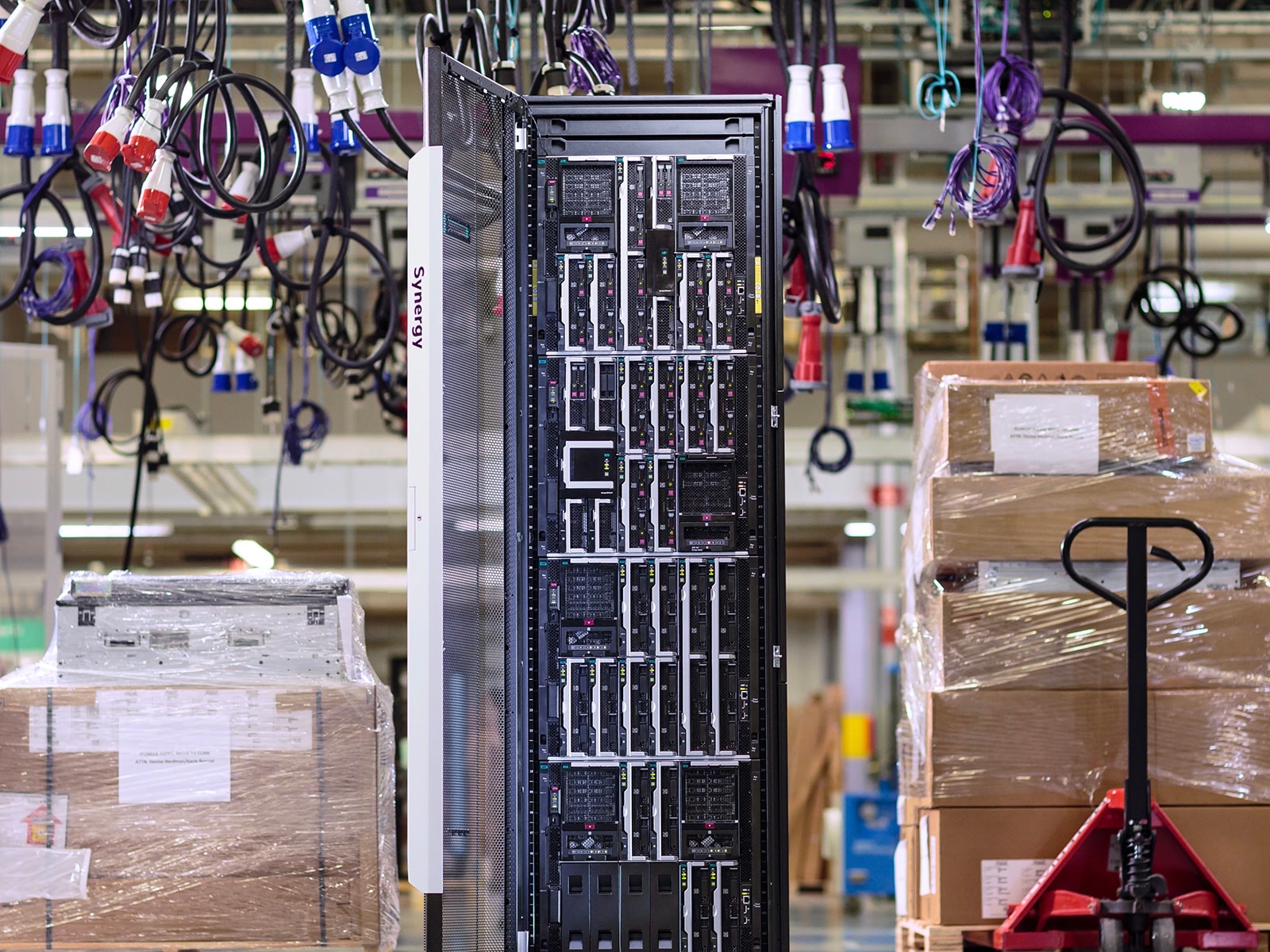
Data Infrastructure What is Data Infrastructure?
Data infrastructure refers to the various components—including hardware, software, networking, services, policies, and more—that enable data consumption, storage, and sharing. Having the right data infrastructure strategy is critical for organizations seeking to undertake data-driven digital transformation.

- What role does data infrastructure play in an organization?
- Why has data infrastructure gotten more complicated?
- How can tools help manage data infrastructure?
- What are the elements of data infrastructure?
- Why does data infrastructure matter?
- What data infrastructure solutions does HPE offer?
What role does data infrastructure play in an organization?
Data infrastructure provides the foundation for an organization to create, manage, use, and secure its data. One of its most critical roles is to ensure that the right data can get to the right users or systems at the right time to make effective data-driven decisions. To meet this goal, an organization must have a solid data infrastructure strategy in place to maintain data flows, protect data quality, minimize redundant data, and prevent crucial data from being isolated into silos.
Why has data infrastructure gotten more complicated?
Recent technology advances have added complexity to data infrastructures. Where previously enterprises may have only needed to concern themselves with their on-premises data center infrastructure, the development of the Internet of Things (IoT), growth at the edge, and the introduction of various cloud computing platforms have extended the data infrastructure landscape and increased the amount of data such infrastructure must support.
How can tools help manage data infrastructure?
As the landscape has expanded, a growing number of tools and platforms have been introduced into the market to oversee various aspects of data infrastructure. While these tools may address specific elements of data infrastructure, having to oversee and manage multiple solutions can also create additional complexity and place additional burdens on IT teams. Consolidation and standardization throughout the data infrastructure stack provides enterprises with scalable access to data across teams and functions.
What are the elements of data infrastructure?
Data infrastructure includes the physical infrastructure of the data center facility, the information infrastructure that encompasses the systems and environments that create and support data, and the business infrastructure of high-level business systems.
Exactly what elements are considered part of the data infrastructure can differ from organization to organization, and even from person to person within an organization. Some of the possibilities include:
Physical infrastructure
- Storage hardware
- Processing hardware
- I/O networks
- Data center facilities (including power, rack space, and network connectivity)
Information infrastructure
- Business applications
- Data repositories (including databases, data warehouses, data lakes, data marts, and data lakehouses)
- Virtualization systems
- Cloud resources and services [including Software as a Service (SaaS) applications, virtual services]
Business infrastructure
- Business intelligence (BI) systems
- Analytics tools [including Big Data, artificial intelligence (AI), and machine learning (ML) systems]
Across these elements are all the personnel, services, policies, and processes involved in creating, moving, protecting, processing, securing, and serving data throughout the organization, from core to edge to cloud.
Why does data infrastructure matter?
Organizations realize that data is a key asset, and they are increasingly seeking to unlock the value of their data for competitive advantage. As the amount of data available within the enterprise is skyrocketing, from edge to cloud, having a well-thought-out data infrastructure strategy is vital to manage costs while meeting the needs of the business.
One of the fundamental issues in any digital transformation project is making sure the organization’s data infrastructure is properly aligned with their desired future state. Balancing storage and analytics demands with the costs of each possible solution is a significant consideration. Getting the infrastructure strategy wrong can inhibit business agility, preventing the organization from being able to capitalize on newly emerging business opportunities and meet new customer demands. If data is trapped in silos and inaccessible to the users or systems that need it, the ability to make effective decisions is hindered, increasing risk and costs. And if the correct security and governance controls are not applied consistently enterprise-wide, it opens the organization up to potential regulatory actions and damage to its corporate reputation.
Traditional infrastructure
Traditional infrastructure has each element of the overall solution individually selected and purchased. While this option offers the greatest degree of choice and customization to an organization’s specific needs, purchasing and managing this type of infrastructure is often complex.
Converged infrastructure
Converged infrastructure is a model in which the infrastructure is purchased as a complete system from a single vendor, with all the hardware and software components validated to work together.
Hyperconverged infrastructure
Hyperconverged infrastructure (HCI) is a software-defined approach designed to make the infrastructure more flexible and manageable. It combines all of an organization’s storage, compute, networking, and virtualization into a single integrated solution.
The cloud
The cloud makes many elements of data infrastructure available to users over the Internet. It provides access to on-demand system resources without the need to maintain the physical infrastructure elements directly.
What data infrastructure solutions does HPE offer?
HPE offers a broad range of data infrastructure solutions to meet the needs of various enterprise workloads. These solutions cover storage, compute, networking, and management tools to support both traditional and modern IT environments. Here's an overview of some key offerings:
Storage solutions
HPE Alletra:
A cloud-native data infrastructure that offers the flexibility to run any application without compromise, providing both performance and simplicity.
HPE StoreOnce:
Backup and recovery solutions that offer efficient, scalable, and high-performance data protection.
Compute solutions
HPE ProLiant Servers:
A broad range of servers designed for various workloads, from entry-level to mission-critical applications.
HPE Synergy:
A composable infrastructure that allows for fluid resource allocation, making it suitable for hybrid IT environments.
HPE Edgeline:
Converged edge systems that bring enterprise-class computing and storage to the edge of the network.
Hyperconverged and composable infrastructure
HPE SimpliVity:
Hyperconverged infrastructure that combines compute, storage, and networking into a single, scalable solution.
HPE Synergy:
A composable infrastructure platform that integrates compute, storage, and networking resources into shared pools.
Networking solutions
HPE Aruba Networking:
A comprehensive portfolio of networking solutions, including switches, access points, and network management software, designed for both wired and wireless environments.
HPE FlexNetwork:
A range of networking solutions that provide scalability, security, and high performance for enterprise environments.
Data management and analytics
HPE Ezmeral:
A software portfolio designed for container orchestration, AI/ML, and data analytics, enabling enterprises to manage and analyze data more effectively.
HPE InfoSight:
Predictive analytics platform that uses AI to optimize and manage IT infrastructure, improving performance and reducing downtime.
Cloud and hybrid IT solutions
HPE GreenLake:
An as-a-service offering that provides a cloud-like experience for on-premises infrastructure, enabling flexible consumption-based pricing.
HPE Cloud Volumes:
A multi-cloud storage service that allows data to be stored and accessed across different cloud platforms seamlessly.
Data protection and backup
HPE StoreOnce:
Efficient backup and recovery solutions with advanced deduplication capabilities.
HPE Data Protector:
Enterprise backup and disaster recovery software that provides comprehensive data protection.
Edge and IoT solutions
HPE Edgeline Converged Edge Systems:
Systems designed to bring computational power closer to the data source, optimizing edge and IoT applications.
HPE Aruba Networking EdgeConnect:
SD-WAN solutions that enhance connectivity and security at the edge.
Management and automation
HPE OneView:
A unified management platform that simplifies infrastructure management through automation and a software-defined approach.
HPE iLO (Integrated Lights-Out):
Remote server management software that provides out-of-band management capabilities.
HPE InfoSight:
Predictive analytics and AIOps platform that leverages AI to optimize and automate IT operations.
These data infrastructure solutions are designed to help organizations manage their data more efficiently, improve performance, and ensure high availability and security.
